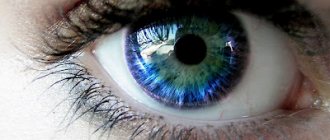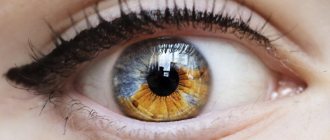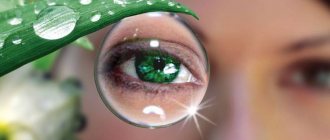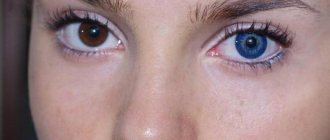The most interesting thing for future parents is to think whether the baby will be a girl or a boy, whose nose the baby will have and what kind of eyes he will have - blue, like his mother's, brown, like his grandfather's, or maybe green, like his great-grandmother's? With gender, it’s somehow simpler; on an ultrasound, if the mother wants, they will most likely tell who will be born, but what about eye color? After all, I can’t wait to imagine how the baby will be born! With appearance, everything is not so simple, but the “mirror of the soul”... You can guess the color of the child’s eyes. A table for determining the shade of the iris exists and will help with this.
What determines the color of a child's iris?
Texture, pigmentation, tissue and vascular factors in the organs of vision. They constitute a unique characteristic of a person.
What determines the color of a child’s eyes is of interest to new or expectant mothers and fathers.
There are 2 conditions that help determine the tone: the amount and pattern of dark brown pigment (known in medicine as melanin) in the part of the visual organs located between the cornea and the lens.
What role does melanin play?
Melanin is produced by cells called melanocytes. This is a pigment that is responsible for the tone of the skin and eyes. Just as sunlight turns the skin into a dark tone, it does the same with the tint through the iris. When a baby is born and exposed to bright light, this light triggers the production of melanin in the choroid, which leads to a change in color.
Excessive accumulation of melanin leads to the development of pathological conditions and irreversible changes in the tone of the iris.
Genetic trait
Color inheritance comes from mother and father. Genetics plays a significant role. Normal diploid cells have 46 chromosomes, divided into 22 pairs of autosomal chromosomes and a pair of sexual chromosomes, X and Y. The embryo (early stage of human development) inherits one from each.
Human cells are composed of fragments of deoxyribonucleic acid. Scientists have discovered that up to 16 material carriers of heredity take part in determining color. OCA2 and HERC2 are considered responsible for this; they are part of the 15 nucleoprotein structure in the nucleus of eukaryotes. Genes consist of different forms of the same gene located on the same homologous chromosomes.
For each trait that the baby will inherit, there are 2 allelic genes. If they are similar, they are called homozygous. If they are different, then they are heterozygous. For each trait, one allele (dominant) is expressed, while the other (recessive) is not expressed (the trait it represents does not appear). Recessive ones are expressed only in the absence of a dominant one.
Alleles for shades are usually divided into blue, green and brown. Greens suppress blues, and browns suppress greens and blues. If the baby got blue and brown, the eye color will be brown because it is dominant. If a daughter/son has a blue iris, this means that he received blue alleles from his mother and father.
Genes determine color. The material carrier of heredity determines how much melanin is produced in the iris. The more pigment produced, the darker the color. Because melanin production begins at birth, babies' irises appear blue.
It follows from this that heredity affects the shade of the newborn’s visual organs. It is transmitted from parents along with DNA fragments contained in chromosomes.
Have you noticed how people's irises change depending on the brightness of the room? This happens because the choroid is made up of two layers. Sometimes the pigment is present in both layers. Depending on the brightness and diffraction of solar energy perceived by the organ of vision, it can change color.
On some faces they are of different tones. This occurs due to a condition called heterochromia.
When the color changes
The most dramatic changes in tone occur when the baby is 6–9 months old. At this point, enough pigment has accumulated to predict what the final shade will be. But there is a high probability that the color will change.
Green eyes slowly turn to brown, or brown to brown. Changes will occur until the age of three. In approximately 10% of the population, eye shade can change in adulthood.
The baby's eyes will remain blue
Most newborns have blue irises, which may change color over time. Eyes remain blue if both parents pass on their recessive blue genes to the baby. If this is not the case, the color changes to permanent (brown, green or any other).
Most babies of Caucasian origin have dark blue eyes at birth. However, the original tone changes.
Similarly, babies of Asian and African descent have a brown or dark gray tone at birth. Over time they turn black or brown.
Is it true that all newborns have blue eyes?
Is it true that all children are born with blue eyes? What color the eyes of newborns actually are and how genetics affects a child’s appearance, read the material.
If you are a first-time mother, then, of course, you have much less experience than mothers with several children. And this is absolutely natural. It is also natural that you have come across various facts about newborns that may or may not be true.
For example, you've probably heard that all children are born blue-eyed. What does a newborn actually look like? Unless you are a nurse in a maternity ward who sees hundreds of babies every day, it is quite difficult to know the truth, even if you regularly read how a child develops month by month. Well, let's find out.
What is the truth? First of all, not all babies are born with blue eyes. African-Americans, Spaniards, and Asians have dark eyes from birth, which remain so throughout their lives. This is because these ethnic groups naturally have pigment in their skin, eyes and hair. The pigment is called melanin, and it predominates in darker-skinned representatives of the human race.
Read also: Scientists have discovered that babies cry in their native language
White-skinned people have less melanin, which is why the color of their hair, skin and eyes may change. People with blue eyes have the least amount of melanin in the iris, while the average amount of pigment results in green or brown eyes. Those people who have the most melanin have dark brown eyes, and the shade can vary.
Yes, it is true that white-skinned children are most often born with blue or gray eyes, which change color over time. This happens because the pigment level increases compared to the original level. Thus, the eye color of newborns does not always remain the same as the child grows. So, if your baby has light eyes now, this does not mean at all that they will remain so when he grows up a little - even in infancy, they can turn green, brown or dark brown.
The eye color of your partner and other family members will help predict what eye color your child will have in the future. To make it easier for you, look at the table, which shows the percentage probability of a baby's eye color depending on the parent's eye color.
So now you know everything you need to know what color your baby's eyes will be when he grows up.
Read also: 29 things only new parents can understand
Read also: Physical development of a child in the first three months of life
Read also: What feats is a baby capable of in the first days of life?
Table of possible eye colors for a child
You can calculate the color of a child's eyes. There is a table with which modern society is able to determine the shade of a baby’s iris.
On the left side is a combination of the father's and mother's eyes. They are depicted in the form of color drawings. The right column shows the iris tone that a newborn will get. The percentage is indicated below them; it means what color the baby is most likely to get.
For example:
- Both parents have brown eyes - the probability that the child will have the same is 75% (brown is dominant, which is why babies rarely have blue eyes).
- If one parent is green and the other is brown, the latter is dominant, green is recessive. This means that as the baby grows older, there is a greater chance of getting a brown tone - 50%, and only 37.5% is allocated to the fact that the newborn will have a green iris.
- If the mother and father have green eyes, then in 75% of cases the baby will have a similar color, in 24% - blue and 1% chance of brown eyes.
Information on other options is understood in the same way.
Yellow eyes are very rare. This variation occurs when there is an excess amount of lipofuscin (this is the end product of oxidation within cellular lipids and proteins). More often than not, this tone indicates the presence of kidney disease.
Amber shades are also associated with excess lipofuscin. Eyes can be light amber or dark.
Black eyes in a newborn mean an excess amount of melanin. There is so much of it that light rays are almost completely absorbed. This color type is common among people of the Mongoloid race, in East and South Asia.
Principles of inheritance of eye color
The color of a person's eyes depends on the pigmentation of the iris, which contains chromatophores with melanin.
If there is a lot of pigment, the eyes turn out brown or hazel, and in blue-eyed people the production of melanin is impaired. A mutation that occurred not so long ago, about seven thousand years ago, is responsible for the light color of the eyes. Gradually it spread, but the mutated gene is recessive, so there are many more brown-eyed people on the planet. In a simplified form, the laws of inheritance can be described as follows: when a germ cell is formed, the human chromosome set is divided into two halves. Only one second of the human genome enters the cell, including one gene responsible for eye color. When two sex cells merge to form an embryo, genes meet each other: in the area responsible for eye color, there are two genes. They will remain in the genome of the new person, but only one can manifest itself in the form of external signs - a dominant one, which suppresses the action of another, recessive gene.
If there are two dominant ones, for example, those responsible for brown eye color, then the child’s eyes will be brown, if there are two recessive ones, then they will be light.
Exceptions to the rules
According to Mendel's laws, dominant genes suppress the totality of biological properties and characteristics of an organism with light-colored recessive genes. It is believed that dark-skinned people give birth to the same baby, the same goes for hair and color.
Not only parents, but also close relatives can influence coloration. Grandparents also influence skin and eye shade. If light-colored parents gave birth to a dark-skinned baby, it means there was a dark-skinned great-grandmother in the family. This also applies to babies with eye colors different from their parents.
Some babies have violet-colored visual organs. This is due to the lack of melanin in the iris. This phenomenon is normal. Such eyes are incredibly beautiful and attractive.
You should be concerned if your eyes are different colors and there are other signs indicating the development of a disease. For example:
- Heterochromia is a rare condition in which a newborn's eyes have two different tones. The cause is believed to be a gene change that leads to excessive pigmentation in one of the irises. In rare cases, different colors of different parts of the iris of one visual organ are observed.
- Waardenburg syndrome. A gene mutation occurs that causes changes in the level of pigmentation of the hair, iris and skin. Waardenburg syndrome is also accompanied by sensorineural hearing loss in some children.
It is important to know that eye color changes depending on the color of clothing, environment, stressful situations and emotional turmoil.
What eye color are most children born with, and when does it change?
The eyes of a newly born baby are most often blue or blue. This color scheme occurs in 9 cases out of 10.
There is a scientific explanation for this fact: the fact is that the pigment melanin, which is involved in the formation of the shade of the iris, begins to be produced with age.
When a baby is born and opens its eyes, cells - melanocytes - begin to produce melanin. By the way, it is melanocytes that determine constitutional melanin pigmentation (skin tone). The number of these cells is determined by heredity.
Most babies' eyes acquire their final shade only when they reach one year, and not immediately after birth. Green and honey tones can take up to five years to develop.











